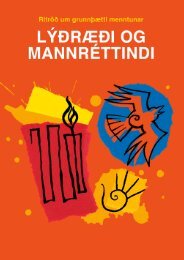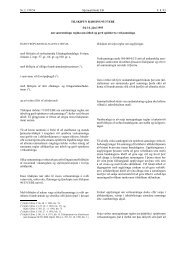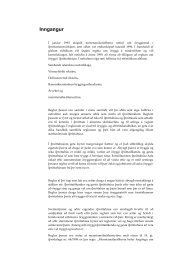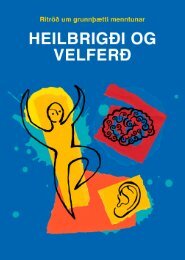Arts and Cultural Education in Iceland : Professor Anne Bamford
Arts and Cultural Education in Iceland : Professor Anne Bamford
Arts and Cultural Education in Iceland : Professor Anne Bamford
You also want an ePaper? Increase the reach of your titles
YUMPU automatically turns print PDFs into web optimized ePapers that Google loves.
‣ Schools <strong>and</strong> colleges should be encouraged to display students’ work more<br />
professionally<br />
In the compulsory school (6-16 year old pupils), <strong>in</strong> most cases, specialists teach visual arts,<br />
textile, wood craft, music <strong>and</strong> – where available – dance. In the upper secondary school,<br />
teachers with specialist tra<strong>in</strong><strong>in</strong>g teach all the arts, craft, design <strong>and</strong> cultural subjects. Specialist<br />
teachers are generally very well qualified hav<strong>in</strong>g either a first degree <strong>in</strong> their chosen art form<br />
<strong>and</strong> a post-graduate diploma or degree <strong>in</strong> education; or a general education degree with a major<br />
specialization <strong>in</strong> their chosen art form. Even <strong>in</strong> preschools, specialist teachers are employed <strong>in</strong><br />
the arts (especially music <strong>and</strong> visual arts) at a very high level, accord<strong>in</strong>g to <strong>in</strong>ternational<br />
st<strong>and</strong>ards. In Figure 1.8.1 it can be seen that music <strong>and</strong> visual arts are quite regularly taught by<br />
specialists.<br />
Figure 1.8.1 Specialist teachers <strong>in</strong> the preschool<br />
A small number of teachers <strong>in</strong> the arts subjects <strong>in</strong> the compulsory school are unqualified.<br />
This is most likely to be the case <strong>in</strong> rural areas or areas where staff<strong>in</strong>g of positions may be more<br />
difficult. Generally though, even the teachers without formal qualifications are considered by<br />
the school leadership to be experienced, enthusiastic <strong>and</strong> committed. A number of the<br />
‘unqualified’ teachers may also have significant <strong>in</strong>dustry experience (for example, they may be<br />
carpenters, designers, professional artists or musicians).<br />
Despite the overall high st<strong>and</strong>ard of teachers, there appears to be a shortage of music<br />
teachers tra<strong>in</strong>ed <strong>and</strong> confident to teach music with<strong>in</strong> the compulsory school context (as opposed<br />
to after school music schools). Music teachers f<strong>in</strong>d the challenges of teach<strong>in</strong>g a whole class <strong>and</strong><br />
more general music education to be a less attractive options than teach<strong>in</strong>g <strong>in</strong> specialized music<br />
schools, so there is a dra<strong>in</strong> away of qualified teachers from the compulsory school sector to the<br />
after school music school. Teach<strong>in</strong>g <strong>in</strong> the Music Schools is preferred to teach<strong>in</strong>g <strong>in</strong> the general<br />
school as teach<strong>in</strong>g is generally on a one-to-one basis <strong>and</strong> with more favourable ‘physical’ <strong>and</strong><br />
cultural environments for music education <strong>in</strong> the music schools.<br />
The teachers <strong>in</strong>terviewed <strong>in</strong> this research appeared committed, with many examples evident<br />
of teachers work<strong>in</strong>g <strong>in</strong> excess of school hours <strong>and</strong> also stay<strong>in</strong>g after school to do extra activities<br />
such as choir classes, festivals <strong>and</strong> theatre productions.<br />
By <strong>in</strong>ternational st<strong>and</strong>ards, the schools are well-equipped <strong>and</strong> effectively organised.<br />
Classrooms <strong>in</strong> the many schools visited were attractive, light <strong>and</strong> well-ma<strong>in</strong>ta<strong>in</strong>ed, with<br />
computers <strong>and</strong> other technology readily available. The schools visited had good-sized halls, or<br />
similar spaces suitable for hold<strong>in</strong>g performances <strong>and</strong> exhibitions. Most schools have specialist<br />
art rooms, <strong>in</strong>clud<strong>in</strong>g wet areas for pa<strong>in</strong>t<strong>in</strong>g, music spaces <strong>and</strong>/or flexible project spaces. Schools<br />
27



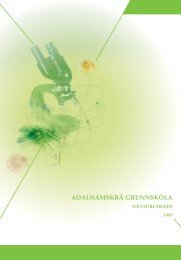
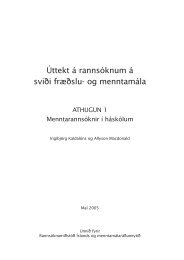

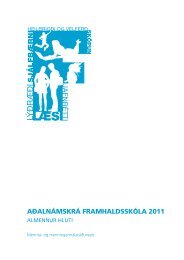
![Aðalnámskrá tónlistarskóla : rytmÃsk tónlist [Eingöngu á rafrænu formi]](https://img.yumpu.com/50843672/1/184x260/aaalnamskra-tanlistarskala-rytma-sk-tanlist-eingangu-a-rafranu-formi.jpg?quality=85)
